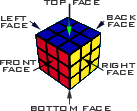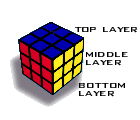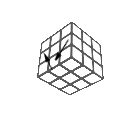Use this
to print the solution.
Rubik's Cube
Solution
When solved, every face of Rubik's Cube
is a solid color. Once you start turning, twisting and
flipping, it's easy to mix up the colors. Not to worry -
Rubik's Cube can be set right from any mixed-up
combination. The following steps will help you solve the
puzzle.
When you play with the cube you turn its
LAYERS, but you want to make the FACES have solid
colors. There are 26 CUBES on the outside of Rubik's
Cube and an invisible "cubie" - which is a rotating
mechanism - in the middle. There are 8 corner cubes with
3 colors, and 12 edge cubes with two colors. There are 6
center cubes with one color. The center cubes cannot
move, being FIXED. So, if you have the original Rubik's
Cube, the blue center cube is always opposite the green,
red is opposite orange, and yellow is opposite white.
The color of the center cube determines the color of
that face.
Note: we use the color
arrangement of the original Rubik's cube because this is
the one Erno Rubik prefers. (i.e. blue is opposite
green, red opposite orange, and yellow is opposite to
white; if the blue side is on the top, then the red is
on the left and the yellow on the right, and so on), The
new Rubik's Cubes currently sold in stores and online
are colored differently (i.e. blue is opposite to white,
green is opposite to yellow, and red is opposite to
orange). If you have a new Rubik's Cube for all the
moves below take it in your hands so that the front face
with the logo is towards you.
NOTATION
 
Moves:
 |
Turn the front
face clockwise (if you have the cube in your hands
so that that face is towards you - this also
applies to the turns below). |
 |
Turn the front
face anti-clockwise. |
 |
Turn the back
face clockwise. |
 |
Turn the back
face anti-clockwise. |
 |
Turn the right
face clockwise. |
 |
Turn the right
face anti-clockwise. |
 |
Turn the left
face clockwise. |
 |
Turn the left
face anti-clockwise. |
 |
Turn the top face
clockwise. |
 |
Turn the top face
anti-clockwise. |
 |
Turn the bottom
face clockwise. |
 |
Turn the bottom
face
anti-clockwise. |
THE
SOLUTION
1. Now form a cross on the top of
the Rubik's Cube so that the colors of the edge cubes
match the colors of the center cubes!
Usually
it is relatively easy to position the edge cubes of the
top layer in only 2 or 3 moves. The easiest way is first
to put the edge cube to the bottom layer below its
place, turning away the middle layer and the layer which
is opposite the layer where it will fit. Then move the
edge cube to the top, and back the layers you moved
away. Then position the top layer again (it may be
turned away).
2. Position the edge cubes of
the middle layer with your chosen color
orientation!
Use the EDGE SWITCHER or the
EDGE SWITCHER WITH FLIP sequence. If you want only to
flip two neighboring edge cubes, but you don't want to
change their color orientation, use the EDGE SWITCHER
sequence. Find an edge cube on the middle layer. The
colors of two center cubes determine the colors of an
edge cube. The edge cubes that belong to the middle
layer will now be in the middle or bottom
layer.

The EDGE SWITCHER sequence.
Hold the
cube like this before performing this sequence. This
sequence swaps two edge cubes, but keeps the colors
untouched. It forces two corner cubes on the bottom
layer to switch as well, but we need not consider them
for the moment. The sequence keeps every other cube in
place.
The moves of the EDGE SWITCHER sequence
(advance from left to right):
            
If you want to flip the cubes as well,
use the EDGE SWITCHER WITH FLIP sequence.

The EDGE SWITCHER WITH FILIP
sequence
Hold the cube like this before performing
the moves. This sequence switches two edge cubes changes
their color orientation, and forces two corner cubes to
switch as well, but we won't consider that right now.
The sequence keeps every other cube in place.
The moves of the EDGE SWITCHER WITH
FLIP sequence (advance from left to right):
                
2.1. If the edge cube of the middle
layer is in the correct spot but the color orientation
is wrong, move it to the bottom layer with an EDGE
SWITCHER, then back with the appropriate EDGE SWITCHER
sequence.
2.2. To position an edge cube, which is
just next to its place in the bottom layer, use the EDGE
SWITCHER once, or the EDGE SWITCHER WITH FLIP sequence
if you want to change the color-succession as
well.
2.3. If the edge cube you want to position
is not beside its place, but two steps away on the
bottom layer (see the image below, where the cube has
been turned to illustrate the solution clearly so that
the original bottom layer is on the top), use the EDGE
SWITCHER sequence to move it next to its place.
Alternatively you can use a simple quarter twist of the
down face (you can unscramble it later). Now go to
2.2.

2.4. If the edge cube you would like to
position is opposite its location in the middle layer,
then you have to move it to the bottom layer next to its
place using the EDGE SWITCHER sequence (to illustrate
the image below turns the whole cube so that the
original top layer - with the blue center cube - is the
back layer). Then go to 2.1.

2.5. The last alternative case is that
the edge cube is on the other side of your Rubik's Cube
in the middle layer. In this case you have to use the
sequence to move it closer to it's correct spot, and
then place the edge cube next to its correct spot with a
quarter twist or an EDGE SWITCHER. Then another EDGE
SWITCHER to solve the cube.

Now your cube must look like
this:

3. Place the edge cubes of the
bottom layer in correct color orientation!
To
achieve this use one of the two EDGE SWITCHER sequences
without forgetting that now you have to position the 4
bottom edge cubes and work on the bottom layer only!

Hold your cube like this before performing
an EDGE SWITCHER sequence. In this image the two edge
cubes of the bottom layer can be seen on the right, as
the whole cube has been turned left.
First check whether or not you can use
one or two simple quarter twists to position
cubes.
There are two cases:
3.1. The edge cube
you would like to position should be just next to where
you want it. Use the EDGE SWITCHER (or the EDGE SWITCHER
WITH FLIP sequence, if you want to change the
color-orientation as well) once you have turned the
whole cube as indicated in the image above.
3.2.
If the edge cube is opposite where you want it, use the
EDGE SWITCHER to position it next to its place, and then
perform this or the EDGE SWITCHER WITH FLIP sequence
depending whether you want to change colors as well.

If you have completed these sequences,
your cube should bear a crusader's cross on every face.
It is possible that some corner cubes are in their
correct spots with matching colors as well, that's
fine.

4. Place the corner cubes, but don't
worry about their orientation yet!
The SWITCH
THREE CORNERS sequence will help you.

The SWITCH THREE CORNERS sequence.
Hold
the cube like this before performing this sequence. This
sequence switches three corners, but keeps every other
cube untouched.
The moves of the SWITCH THREE CORNERS
sequence (advance from left to right):
       
Again there are a number of possible
starting patterns:
4.1. If you have two neighboring
corners you can position them using the SWITCH THREE
CORNERS sequence (do not worry about the color
orientation). Be sure to hold the whole cube so that the
three corner cubes you want to switch are on top before
performing the sequence.
 4.2. If there is only a center cube
"between" the corner cube and its correct place perform
the SWITCH THREE CORNERS sequence, do this twice if you
want to keep the fourth cube "behind" the three moving
cubes during the sequence. 4.2. If there is only a center cube
"between" the corner cube and its correct place perform
the SWITCH THREE CORNERS sequence, do this twice if you
want to keep the fourth cube "behind" the three moving
cubes during the sequence.
 4.3. If the corner cube is not in the
same layer, use the SWITCH THREE CORNERS sequence twice.
First to move the corner to the same layer, and then go
to 4.2. or 4.1. to perform one or two more sequences.
Turn your Rubik's Cube so the 3 corners are on the top
before each SWITCH THREE CORNERS move sequence. 4.3. If the corner cube is not in the
same layer, use the SWITCH THREE CORNERS sequence twice.
First to move the corner to the same layer, and then go
to 4.2. or 4.1. to perform one or two more sequences.
Turn your Rubik's Cube so the 3 corners are on the top
before each SWITCH THREE CORNERS move sequence.

Having completed that move the 8 corner
cubes will be in the correct spot. Some of them will
have the right color orientation; most of them
won't!
5. Finally correct the colors of the
corner cubes!
Use the CORNER FLIPPER RIGHT or
CORNER FLIPPER LEFT sequence. The CORNER FLIPPER RIGHT
rotates one corner cube clockwise in place, and forces
the next corner to rotate in the other direction. The
CORNER FLIPPER LEFT rotates one corner cube
anti-clockwise in its place, and forces the next corner
to rotate in the other direction. Note that the CORNER
FLIPPER RIGHT is equal to two CORNER FLIPPER LEFTs; so
if you only want to learn 4 move sequences instead of 5,
you can leave out one of the two CORNER FLIPPER
sequences.

The CORNER FLIPPER RIGHT move sequence.
Hold the whole cube like this before performing the
sequence. Make sure the corner cube you want to make the
right color is at the front!
The moves of the CORNER FLIPPER RIGHT
sequence (advance from left to right):
               

The CORNER FLIPPER LEFT sequence. Hold the
whole cube like this before performing the sequence.
Make sure the corner cube you want to make the right
color is at the front!
The moves of the CORNER FLIPPER LEFT
sequence (advance from left to right):
               
Here you have to advance
step by step zigzagging through the corner cubes. Choose
the first to correct randomly or start next to an
already correct corner.
There are three
possibilities here:
5.1. If only one of the two
corners rotated with the sequence gets the right color
orientation, turn your Rubik's Cube so that the
remaining wrong color corner cube is on the front at the
top.
5.2. If both corner cubes get the right
color orientation, use the sequence on one after the
other of the corner cubes. Hold the whole cube
carefully.
5.3. If two opposite corner cubes are
the wrong colors, but the other two corners of the same
layer are right, don't get frustrated. Use one of the
CORNER FLIPPER sequences on one of the wrong and on one
of the right corner cubes. This will make one corner
right and the other corner wrong. Use the sequence on
the corner that is now wrong and the corner that was
wrong.
Ensure the cube you want to
color-orientate is at the front and on top.
When
only two corner cubes have the wrong color-orientation
both will be OK if you have used the proper CORNER
FLIPPER sequence. If you have done that you have solved
the cube.

CONGRATULATIONS!
Try other
solutions
on the web!
Rubik's Fact:
Theoretically the shortest possible path to solving
Rubik's Cube from any scrambled position is as few as 22
twists. So far no one has succeeded in demonstrating
this method.
|